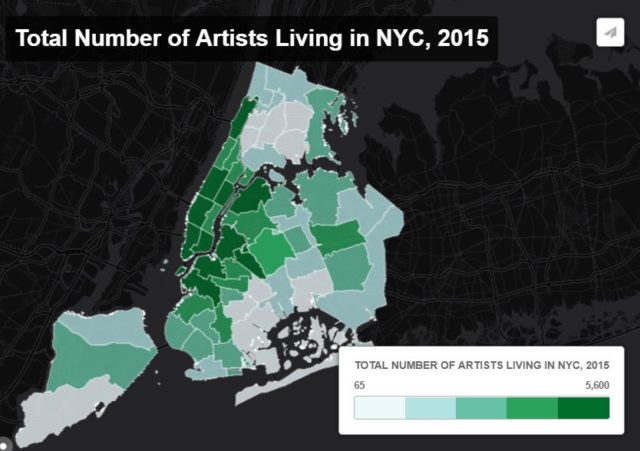As of 2015, there were 56,268 artists living in New York City. That number is a record all-time high, despite our collective nostalgia for the “good old days” of pre-Giuliani bohemia. That’s actually a whopping 17.4% increase since 2000. These statistics, among plenty of fascinating others, can be found in a report released by Center for an Urban Future report released yesterday. [h/t Curbed]
The most interesting part of the study breaks down exactly where those artists live across the five boroughs. For all the talk of Brooklyn’s booming art scene, no outerborough rivals Manhattan’s dominance as far as artist saturation goes. That’s not to say many areas of Manhattan aren’t hemorrhaging artists as rents rise astronomically. The densely-populated area comprising the Financial District, Greenwich Village, and TriBeCa lost nearly a quarter of its artist population—now down to a “mere” 3,989 creative souls. There are even less artists left in the famously artsy Chelsea and Hell’s Kitchen zone, which lost nearly a third of its art population. And despite the much-discussed migration of galleries from Chelsea to the Lower East Side/Chinatown, those downtown neighborhoods collectively lost 17% of their artist residents. For anyone not living under a rock, the increasing unaffordability of those neighborhoods isn’t exactly shocking. But the other side of gentrification is where artists are moving in Manhattan—chiefly, North to Inwood, Washington Heights, and Harlem.
And while Manhattan still reigns supreme as the artist capital of the metropolis, it goes without saying that Brooklyn and Queens have absorbed the majority of the city’s creative population growth, closing the gap somewhat. It’s hard to believe that in 2000 only 150 artists called Bushwick home. In 2015 that number was 1,824—a whopping 1,100% increase. Still, it’s worth noting that the (in)famously hip nabe still only ranks as #11 in terms of total artist population. Other significant population gains were made in Greenpoint/Williamsburgh (duh) though the study suggests those areas are now slowly losing artist too as they gentrify to Manhattan levels.
Ten Neighborhoods with the Most Artists, 2015
1. Upper West Side (5,584)
2. Greenwich Village / Financial District (3,989)
3. Chelsea / Clinton / Midtown (3,711)
4. Upper East Side (3,049)
5. Williamsburg / Greenpoint (2,908)
6. Park Slope / Carroll Gardens (2,602)
7. Brooklyn Heights / Fort Greene (2,445)
8. Lower East Side / Chinatown (2,413)
9. Washington Heights / Inwood (1,995)
10. Astoria / Long Island City (1,919)Ten Neighborhoods with the Largest Increase in Artists, 2000 to 2015
1. Bushwick (+1,674 / 1116%)
2. Williamsburg / Greenpoint (+1,248 / 75%)
3. Brooklyn Heights / Fort Greene (+899 / 58%)
4. Bedford Stuyvesant (+773 / 268%)
5. North Crown Heights / Prospect Heights (+680 / 114%)
6. Central Harlem (+653 / 216%)
7. Astoria / Long Island City (+552 / 40%)
8. Sunset Park (+550 / 124%)
9. Throgs Neck / Co-op City (+472 / 286%)
10. Park Slope / Carroll Gardens (+433 / 20%)
Still, it’s remarkable that Williamsburg and Greenpoint collectively house less artists than the Upper East Side. Which raises some questions about the Census and American Community Survey data used in the study—who exactly self-reports as an “artist”? When we consider who reports visual or performing arts as their profession—well-paid actors, some filmmakers, perhaps designers—it’s not so surprising that the Upper West Side is the most artist-heavy neighborhood in the city. But it’s hard to believe Central Harlem is home to less than 1,000 artists. I wonder how many musicians, aspiring fashion designers, and outsider artists who make their money in other fields didn’t self-identify as an “artist” for their “profession”. How many art school grads in Bushwick reported themselves as “baristas”? The study is fascinating, but it also points to the elusiveness of quantifying data about the arts—definitions are slippery, and often indexed to how income is earned rather than lifestyle.
And, in our experience, sometimes it’s just hard to get those crazy creative types to fill out paperwork.




Comments on this entry are closed.